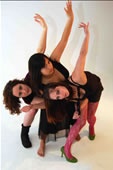An Alternative Version of your Own Life
07/09/2007 - 08/09/2007
Production Details
Choreography by Virginia Kennard & Lorna Borrett
Virginia and Lorna met at the gym, discovered they were both dancers, and wanted to have a dance together! Lorna teaches step and Virginia is a mathematician, but please don’t hold this against them. They have created dance that reflects their everyday confusion and dissatisfaction. But fear not! This is haunting dance theatre to enjoy and contemplate.
Lorna trained in dance in the UK, impressively becoming a BA (Hons). Her studies included Graham and Cunningham techniques teaching her to not smile whilst dancing.
Virginia is a Wellington-based choreographer with a background in theatre producing, wine reviewing and high kicks. Choreographing fulfils her need to boss others around.
Dance , Contemporary dance ,
Impressive treatment of interesting ideas
Review by Shruti Navathe 18th Sep 2007
I attended the opening night of An Alternative Version of Your Own Life at BATS armed with the knowledge the performance I was about to see was the product of the imaginations of two women: a mathematician and a fitness instructor. A random collaboration? I have done enough mathematics to be familiar with the concept of entropy and was expecting that underneath the disorder and seeming randomness there would be order; such is the nature of chaos. What I was left with was a sense that the show set out bravely and creatively to explore complicated concepts for dance; but did not entirely succeed in exploring those concepts in depth. [Read more]
Copyright © in the review belongs to the reviewer
Promise, inventiveness, craft and commitment not always enough
Review by Lyne Pringle 17th Sep 2007
The programme notes for this evening of dance are very fulsome and promise much.
Virginia Kennard present two works. Order within Disorder is based on mathematical theory. The choreographer states very clearly her intentions about the activities of the dancers in the space and their progressions towards and investigation of ‘three chaotic sets’: The Lorenz Attractor, Poincare Recurrence and The Mandlebrot Set. This is ambitious and intriguing material for sure, there is no doubt Kennard brings an intelligence to her work: conceptually driven dance placing the human form in the midst of abstraction with a puzzling overlay of drama to portray intricate intellectual choreography of the mind.
Whilst there is inventive use of repetitive movement to convey these concepts, there is little excitement and eventually the work flounders due to a lack of rhythm and dynamic changes. But there is meaty potential in these explorations. A bold and ever changing lighting design plus video images of The Mandlebrot Set and The Lorenz Attractor add texture to the black box.
Music can intersect with dance in many ways. Throughout this evening of dance the tendency was to have it playing loud and at times obtrusively with movement beginning and ending with a track. Both choreographers could explore other options. Also, in the segues between works, some silence would have been just fine.
Kennard’s second work, The grass is always greener, revolves around a simpler concept of ‘struggle and search’. Here she is stronger choreographically, exploring tight unison and interesting structures in the space. Two tribes in black and white move through various variations on coveting each other’s realities. Some of the floor based choreography really started cooking and cat like gestures held interest as the themes were developed strongly, again propelled by some effective lighting. Celine Catoeen dances well. Motifs of carrying other members of the tribe are repeated: it is pleasing to really sense the weight of a body as it is dragged and lifted and there is a very effective ‘fight’ duet sans use of the lower arm. However clumsy exits and entrances at times highlight how limiting Bats can be as a dance venue. Eventually the strong choreographic craft does not sustain the duration of this work.
Hugger – Mugger, the third work on the programme, is choreographed by Lorna Borret. It is an ambitious work that is all conceptual bones with no meat. Characters appear onstage, we are filled with expectation as dressing becomes a ritual … The dancers then stand suspended, awaiting scenes to inhabit. The soundtrack is compelling at times in this piece, provoking us to create narratives with our ears … But the tension created early on eventually becomes soggy as the piece fails to ignite in terms of energy and rhythm. The element of surprise is not employed after the initial promise.
At times pleasingly odd, the choreography has a nice deliberateness about it. Borret introduces text – always a difficult element in dance – but this is not developed. A pregnant woman, a little girl, a cross dresser, some map reading hip hoppers, a bickering husband and wife and a nostalgic granny move through their various realities until worlds begin to collide with, potentially, some real dramatic juice never fully realised as if the overall dynamic and of the piece is constipated. A step back in time for the Granny provides a lovely moment and the ending is nicely focussed but the work needs more investigation into characters and their relationship to each other: more meat on these bones.
Kennard and Borrett have gathered together an enthusiastic and committed group of dancers who give their all to the choreographies with some pleasing dancing, although there is some unevenness technically which catches and distracts the eye.
Throughout the evening the thoughtful lighting illuminates the choreography.
_______________________________
For more production details, click on the title at the top of this review. Go to Home page to see other Reviews, recent Comments and Forum postings (under Chat Back), and News.
Copyright © in the review belongs to the reviewer
Comments
Make a comment
You must be logged in to post a comment.
Make a comment
You must be logged in to post a comment.





Comments